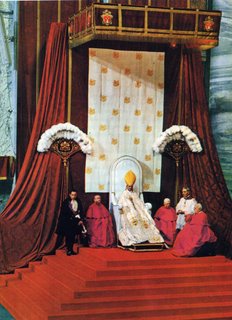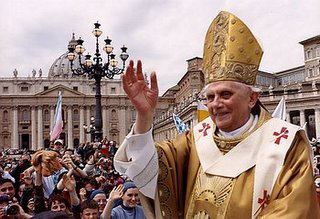"Where Peter is, there the Church is."

Today's Feast of the Chair of St Peter, being an amalgamation of the Chair at Antioch and the Chair at Rome, is essentially a celebration of the episcopal dignity and universal primacy of the Prince of the Apostles, St Peter. It is a celebration of the divinely-instituted Office of the Successors of St Peter, the Bishops of Rome, whom we call Pope. For he who is called to the See of Peter ('see' being an anglicization of the Latin 'sedes', seat) continues and perpetuates the mission given to St Peter, which is to be a "shepherd of the whole flock" of God's Holy Church and to be "the perpetual and visible principle and foundation of unity of both the bishops and of the faithful" (Lumen Gentium, 22, 23). Therefore, today the Church celebrates the unity and the infallible teaching authority given by God to the Church, as entrusted primarily to the Bishop of Rome in the exercise of his Petrine ministry.
What follows is an excerpt from one of my favourite theologians, the Jesuit Cardinal Henri de Lubac, reflecting on the gift of the Petrine ministry. His book, 'The Splendor of the Church', is superlative in the realm of ecclesiology and this is one of the best parts of the book, when the Cardinal meditates on the qualities that an homo ecclesiasticus, a person of the Church, a child of Mother Church, ought to have.
It is perhaps fitting too that I offer this reflection by a Jesuit in recognition of my new friend the Jesuit Scholastic, Mark Mossa SJ, who has so deservedly won the 'Best Blog by a Seminarian' award. May all those who write Catholic web logs and all who read them grow to the full stature of Cardinal De Lubac's vision of the man of the Church and so draw more souls to Christ!
The following quotation is supplemented with the source of the citations because it shows the richness of De Lubac's exposition which is so firmly grounded in Scripture and Tradition. The book is published in translation by Ignatius Press from the French original 'Meditation sur l'Eglise' (1953). Highly recommended spiritual reading for our ecclesiology-impoverished age!
"The Roman Church is the object par excellence of accusations of tyranny; she is even sometimes - absurdly - put on a parallel with the various systems of political absolutism. And she is also the primary object of the objections of many Christians, who nevertheless recognize the necessity of a visible authority. Conversely, it is primarily of her that the Catholic thinks when he calls the Church his Mother. In common with tradition, he considers her as 'root and Mother of the Catholic Church' [St Cyprian], as 'Mother and Mistress of all the faithful of Christ' [Lateran IV]. He considers her head as 'the head of the episcopate' and 'father of the Christian people' [St Augustine], 'the master of the whole household of Christ', as St Ignatius Loyola puts it. For him, the See of Rome is the 'Holy See', the 'Apostolic See' par excellence. He knows that Peter was given the charge of not only the lambs but the sheep as well; that Christ himself prayed that the faith of Peter might not fail; and that he gave Peter the keys of the Kingdom of Heaven and the command to confirm his brethren [Mt 16:18-19]. He realises that Peter personifies the whole Church [St Augustine] and that just as each bishop is the bridegroom of his own particular Church, so Peter, the Bishop of Rome, may be said to be the Universal Church [Pius VI], the whole of which has in him its visible foundation [St Augustine; 1910 anti-Modernist Oath]. As against a frequently lodged objection (based on a misunderstanding), he will, of course, be be equally clear that this visible foundation in no way prejudices that unique Foundation which is Christ, any more than the visible chief shepherd puts into eclipse the Good Shepherd [St Thomas Aquinas], since here there is no question of duplication, the very name 'Peter' having been chosen by Christ to express this identity of submission, which is in itself the fruit of faith [St Augustine]. Believing as he does that the Church has received the promise of perpetuity and victory over death, and holding that it was she who was in Christ's mind in that scene on the road to Caesarea, he will naturally grasp the consequence that as long as the Church oes on building herself up and subsisting in her visible state - that is to say, as long as this world lasts [St Leo the Great; Vatican I] - she cannot be without a visible foundation for her building. Peter was not given his office simply in order to relinquish it almost at once; he was given it to hand on after him. 'In his successors - the bishops of the See of Rome, which was founded by him and consecrated by his blood - he lives, presides and judges perpetually' [The Roman legate, Philip, at the Council of Ephesus].
Finally the Catholic will not be content merely to grant and grasp that in the last analysis the Church is, so to speak, concentrated whole in Peter; the seeing of the fact will be an occasion of joy to him. He will not be worried by those who try to presuade him that he has 'lost the sense of the totality of the Church' and that in submitting himself to the power of the pope he has resigned himself to a belief that is, as it were, merely belief at the word of command - as if 'in Romanism properly understood' the whole doctrine and life of the Church resided only in the single person of its head. For we do not deny the existence of a circle when we know that it must have a centre; and it is no abolishment of the body when we say that it has a head. To superficial explanations of this kind, which are the result of what one might describe as an optical illusion, he will oppose the evidence of faith and reply, in the words of one of his bishops:
"When the pope makes an act of doctrinal authority, this is no exterior yoke imposed by a particular man on a religious society in the name of his own intelligence, even though it might be that of a genius. He is defining the faith of the Church. He is in no way subject to her consent; yet the truth he translates into our language and renders precise is the truth by which she lives; the belief whose meaning he confirms is our belief - he analyzes its content, counters its potential weaknings, and maintains its vigour. Thus, when we say to the Church, in the words which the Apostle used to Christ, who founded her: 'To whom shall we go? Thou hast the words of eternal life', this is not in the virtue of some fatigue of spirit, which seeks to place itself under an authority to escape the effort of thought and the labour of living; rather it is, as Newman put it, in virtue of a sense of coming to rest in the Catholic plenitude" [Mgr Blanchet (Nov 1950)].
He can also appeal in this matter to the declarations of the popes themselves, who, when they are preparing to define some point of faith, far from considering themselves as having to 'pronounce an oracle', weigh up not only Scripture but 'time-honoured tradition, the perpetual belief of the body of the Church, and the agreement of the bishops and the faithful' [Pius IX]. In this way the meaning of papal infallibility becomes clear - as well as the reason for it; it is an infallibility that is not something separate from that of the whole of the Church any more than it is derived from an infallibility of the bishops or other members; it is an infallibility that is in reality that of the Church herself, although, in the case of the man who gives it sovereign interpretation in order to bring all controversy to a close, it is personal and absolute.
That is why, in short, the Catholic recognizes Peter as he who has charge of the universal Church, without any of the petty reservations of Gallicanism. That is why he holds that he is - to quote the expression given authoritative status by the [First] Vatican Council - 'the supreme judge of the faithful' and he who holds the fullness of power in the Church; that is why he makes his own he words of St Ambrose: 'Where Peter is, there the Church is.' He will always see in Peter both the unshakeable rock upon which his own firmness is based [St Leo the Great] and the 'centre of Catholic truth and unity' [Pius IX], the one and only visible centre of all the children of God [Fenelon (July 1710)]. In the authority of Peter he sees the support of his faith and the guarantee of his communion. And thus his fidelity to the Christian faith finds concrete expression in his love for Peter, to whom he is bound, despite all exterior vicissitudes, by every fibre of his soul."
May God bless and protect Pope Benedict XVI, now seated in the Chair of Peter, that he may strengthen his brothers in unity!
The images above are of the Cathedra Petri in St Peter's Basilica, Pope Paul VI seated on the Lateran cathedra and Pope Benedict XVI after his Mass for the Inauguration of the Petrine Ministry last year.









0 Comments:
Post a Comment
<< Home